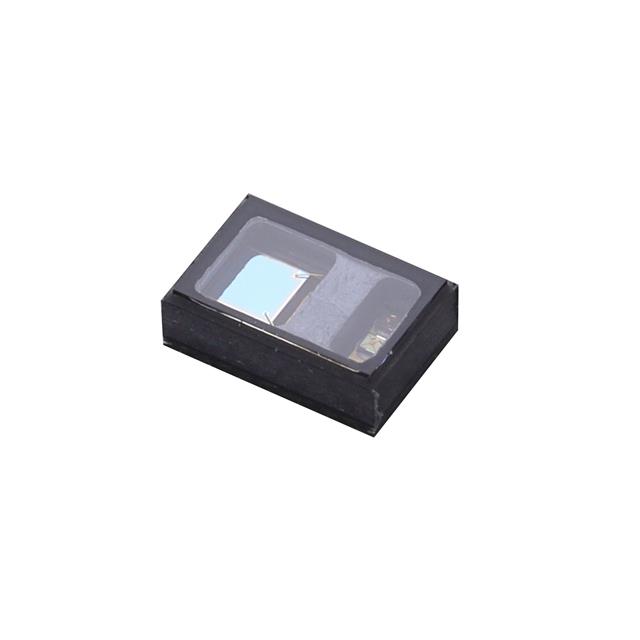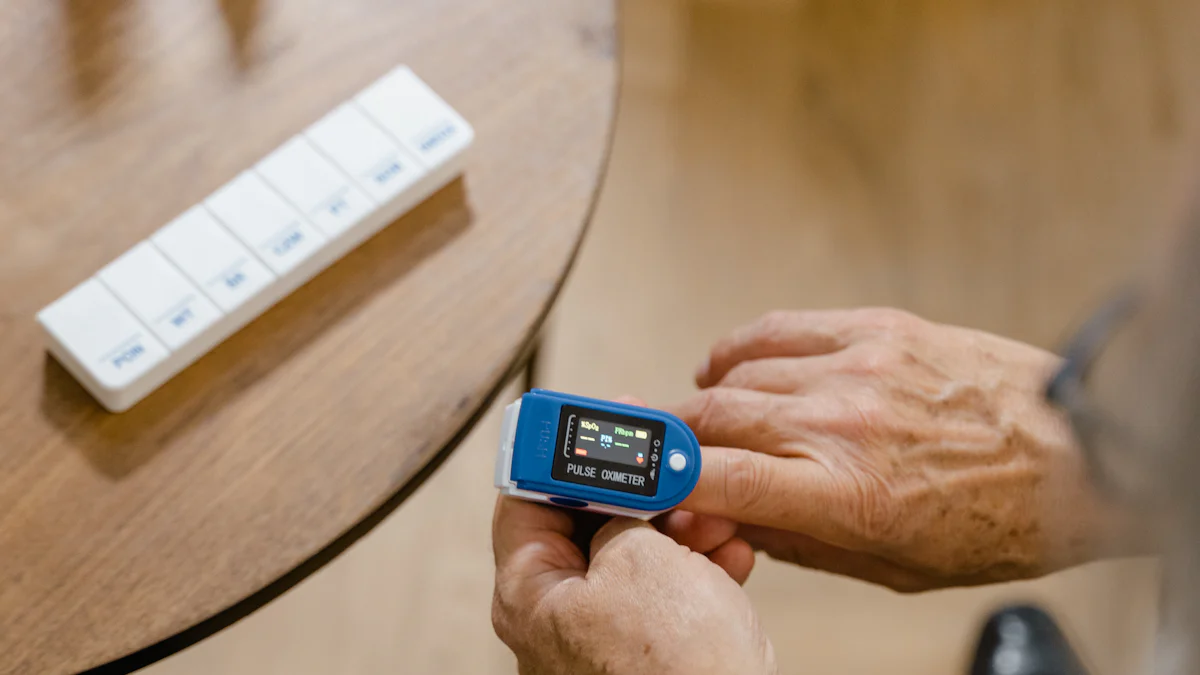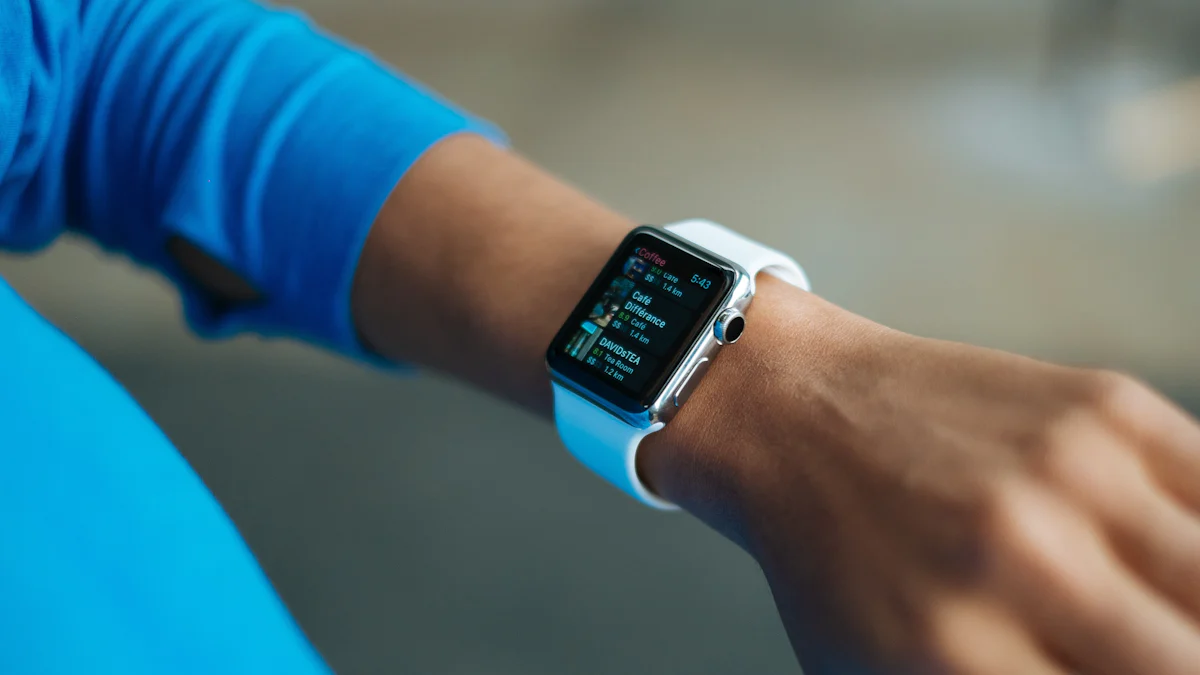How MAXM86161EFD+T Simplifies Health Monitoring Devices

The MAXM86161EFD+T revolutionizes health monitoring device integration with its advanced design and functionality. This ultra-low-power optical sensor combines high sensitivity with a compact form factor, making it ideal for wearable and portable devices. Its integrated features, such as programmable LED drivers and a high-efficiency PIN photodiode, ensure precise biometric measurements. By simplifying the development process, this sensor enables manufacturers to create efficient and accurate health monitoring solutions that cater to both consumer and clinical-grade applications.
You May Also Be Interested In these parts as follow:
LTC4124EV#TRMPBF,AD,LT,
ECS-.327-12.5-1210B-N-TR,ECS,32.768 kHz ±20ppm Crystal,Oscillators, Resonators
MX25R6435FZNIL0, Macronix, FLASH - NOR Memory IC
VL53L8CXV0GC/1,ST,oF Distance Sensor
MLX90632SLD-BCB-000-RE,Melexis ,Temperature Sensor Digital, Infrared
Key Takeaways
The MAXM86161EFD+T sensor is ultra-compact and energy-efficient, making it perfect for wearable health monitoring devices like fitness trackers and smartwatches.
With a high signal-to-noise ratio, this sensor ensures accurate biometric measurements, crucial for reliable health monitoring in both consumer and clinical applications.
Its multi-wavelength optical sensing capabilities allow for the measurement of vital signs such as heart rate, SpO2, and heart rate variability, enhancing its versatility.
Developers benefit from pre-configured features and comprehensive documentation, which streamline the integration process and reduce development time.
Proper sensor placement and calibration are essential for achieving accurate readings, ensuring that the device performs optimally in various environments.
The sensor's low power consumption extends battery life, providing users with longer device uptime for continuous health monitoring.
By simplifying the development process, the MAXM86161EFD+T empowers innovators to create next-generation health monitoring solutions.
Overview of the MAXM86161EFD+T Sensor

The MAXM86161EFD+T sensor stands out as a cutting-edge solution for health monitoring devices. Its advanced design and integrated features make it a preferred choice for developers seeking efficiency, accuracy, and compactness in their applications. This section delves into the key features and specifications of the sensor, as well as its diverse applications in health monitoring.
Key Features and Specifications
Compact size and low power consumption
The MAXM86161EFD+T boasts an ultra-compact form factor, making it ideal for wearable and portable devices. Its small size allows seamless integration into devices like fitness trackers and smartwatches without compromising functionality. Additionally, the sensor's ultra-low power consumption ensures extended battery life, which is crucial for devices that require long-term usage without frequent recharging.
High signal-to-noise ratio for accurate readings
Accuracy is paramount in health monitoring, and the MAXM86161EFD+T delivers exceptional performance with its high signal-to-noise ratio (SNR). This feature minimizes interference and ensures precise biometric measurements, even in challenging environments. The sensor's advanced analog front-end (AFE) and 19-bit ADC further enhance its ability to capture reliable data.
Multi-wavelength optical sensing capabilities
The sensor integrates multi-wavelength optical sensing capabilities, enabling it to measure various vital signs such as heart rate, pulse oximetry (SpO2), and heart rate variability (HRV). Its programmable LED drivers and high-efficiency PIN photodiode work together to provide accurate and consistent readings across different applications.
Applications in Health Monitoring Devices
Heart rate, SpO2, and HRV measurements
The MAXM86161EFD+T excels in measuring critical health parameters, including heart rate, SpO2, and HRV. These metrics are essential for monitoring cardiovascular health, oxygen saturation levels, and stress or recovery states. The sensor's precision ensures that both consumer and clinical-grade devices can rely on its data for informed decision-making.
Compatibility with wearable and portable devices
Wearable and portable devices demand sensors that are compact, efficient, and easy to integrate. The MAXM86161EFD+T meets these requirements with its small size and flexible design. Its compatibility with microcontrollers via I2C communication simplifies the integration process, making it suitable for a wide range of embedded systems.
Use in clinical-grade and consumer healthcare applications
The versatility of the MAXM86161EFD+T extends to both clinical-grade and consumer healthcare applications. In clinical settings, the sensor supports devices that require high accuracy and reliability. For consumer products, it enables the development of user-friendly health monitoring solutions that cater to everyday wellness needs.
Step-by-Step Integration Guide for MAXM86161EFD+T
Integrating the MAXM86161EFD+T sensor into health monitoring devices requires a systematic approach. This guide outlines the essential steps for hardware setup, software configuration, and testing to ensure optimal performance.
Hardware Setup
Pin configuration and connection to the microcontroller
The MAXM86161EFD+T features a straightforward pin configuration that simplifies integration. Developers should connect the sensor's I2C pins (SCL and SDA) to the corresponding microcontroller pins. The interrupt pin (INT) can be used to signal data availability. Proper grounding of the GND pin ensures stable operation. Referencing the datasheet provides detailed pin descriptions and electrical characteristics.
Power supply requirements and considerations
The sensor operates efficiently with a supply voltage range of 1.8V to 3.6V. A stable power source is critical to avoid fluctuations that may affect readings. Adding decoupling capacitors near the power pins helps minimize noise. Ensuring the power supply meets these requirements enhances the sensor's reliability.
Placement and alignment for optimal performance
Proper placement of the sensor is crucial for accurate measurements. Aligning the optical window with the skin surface ensures effective light transmission and reflection. Avoiding obstructions like thick casings or opaque materials improves signal quality. Following layout guidelines from the datasheet ensures optimal sensor performance in wearable and portable devices.
Software Configuration
Installing drivers and libraries
To begin, developers must install the necessary drivers and libraries for the MAXM86161EFD+T. These resources enable communication between the sensor and the microcontroller. Many development platforms provide pre-built libraries, which simplify the setup process. Checking for updates ensures compatibility with the latest firmware.
Configuring the sensor for specific applications
The sensor's registers allow customization for various applications. Developers can configure LED pulse amplitude, sampling rates, and operating modes through I2C commands. For example, adjusting the LED sequence registers optimizes the sensor for heart rate or SpO2 measurements. The datasheet provides pseudo-code examples to assist with configuration.
Interfacing with the microcontroller via I2C
The I2C interface facilitates seamless communication between the sensor and the microcontroller. Developers should set the correct slave address and clock speed for the I2C bus. Using the provided register map, they can read and write data to configure the sensor. Testing the I2C connection ensures proper functionality before proceeding.
Testing and Calibration
Verifying sensor functionality
Initial testing confirms that the sensor operates as expected. Developers can use diagnostic registers to check for errors or malfunctions. Reading raw data from the FIFO register verifies that the sensor captures signals correctly. This step ensures the hardware and software setup is complete.
Calibrating for accurate biometric measurements
Calibration enhances the accuracy of biometric readings. Using reference samples, developers can adjust the sensor's gain and offset values. For example, calibrating with known SpO2 levels ensures precise oxygen saturation measurements. Regular calibration maintains accuracy over time.
Troubleshooting common setup issues
If issues arise, developers should verify connections, power supply stability, and I2C communication. Checking for compatibility between the sensor and microcontroller resolves many problems. Reviewing the datasheet's troubleshooting section provides additional guidance for addressing setup challenges.
Key Benefits of Using the MAXM86161EFD+T

The MAXM86161EFD+T sensor offers numerous advantages that enhance the development and functionality of health monitoring devices. Its innovative design and advanced features provide measurable benefits for developers and end-users alike.
Enhanced Device Performance
Accurate health monitoring metrics
The MAXM86161EFD+T delivers precise biometric measurements, ensuring reliable health monitoring metrics. Its high signal-to-noise ratio (SNR) minimizes interference, enabling accurate readings of vital signs such as heart rate, SpO2, and HRV. This level of accuracy supports both clinical-grade devices and consumer health applications, where dependable data is essential for informed decision-making.
Reliable performance in various environmental conditions
Environmental factors, such as temperature and humidity, can impact sensor performance. The MAXM86161EFD+T maintains consistent functionality across a wide range of conditions. Its robust design ensures reliable operation, making it suitable for wearable devices used in diverse settings, from fitness activities to medical environments.
Faster Development Time
Pre-configured features for rapid prototyping
Developers benefit from the sensor's pre-configured features, which simplify the prototyping process. Built-in programmable LED drivers and an efficient analog front-end (AFE) reduce the need for extensive customization. These features allow developers to focus on refining their applications rather than spending time on complex configurations.
Comprehensive documentation and support
The MAXM86161EFD+T comes with detailed documentation, including datasheets, application notes, and example code. These resources provide clear guidance for hardware setup, software integration, and calibration. Additionally, technical support from Maxim Integrated ensures that developers can resolve challenges quickly, further accelerating the development timeline.
Improved User Experience
Compact design for lightweight devices
The sensor's ultra-compact form factor enables the creation of lightweight and ergonomic devices. Its small size allows seamless integration into wearables like smartwatches and fitness trackers without adding bulk. This compactness enhances user comfort, encouraging consistent device usage for health monitoring.
Low power consumption for extended battery life
The MAXM86161EFD+T excels in energy efficiency, consuming minimal power during operation. This feature extends the battery life of portable devices, reducing the frequency of recharging. Users benefit from longer device uptime, which is particularly valuable for continuous health monitoring applications.
Common Challenges and Solutions for MAXM86161EFD+T Integration
Integrating the MAXM86161EFD+T sensor into health monitoring devices can present challenges. Developers often encounter issues during hardware setup, software configuration, and calibration. Addressing these challenges ensures optimal sensor performance and reliable health monitoring metrics.
Hardware Integration Issues
Addressing power supply inconsistencies
Power supply inconsistencies can disrupt sensor functionality. Developers should ensure a stable voltage supply within the sensor's operating range of 1.8V to 3.6V. Adding decoupling capacitors near the power pins minimizes noise and voltage fluctuations. Using a regulated power source further enhances stability. Regularly monitoring the power supply during operation helps identify and resolve inconsistencies early.
Ensuring proper sensor placement for accurate readings
Accurate readings depend on correct sensor placement. Developers should align the optical window with the skin surface to maximize light transmission and reflection. Avoiding obstructions, such as thick casings or opaque materials, improves signal quality. Testing different placements during the design phase helps identify the optimal position for consistent performance.
Software Configuration Problems
Debugging communication errors with the microcontroller
Communication errors between the sensor and the microcontroller often arise from incorrect I2C configurations. Developers should verify the I2C slave address and clock speed settings. Checking the physical connections of the SDA and SCL pins ensures proper data transmission. Using diagnostic tools, such as logic analyzers, helps identify and resolve communication issues effectively.
Resolving driver or library compatibility issues
Driver or library compatibility issues can hinder software integration. Developers should use the latest drivers and libraries provided by the manufacturer. Verifying compatibility with the microcontroller's development platform prevents conflicts. Reviewing example code and application notes simplifies the integration process. Testing the software on a development board ensures smooth operation before deployment.
Calibration and Testing Challenges
Overcoming inaccurate readings during initial setup
Inaccurate readings during initial setup often result from improper calibration. Developers should use reference samples to adjust the sensor's gain and offset values. For example, calibrating with known SpO2 levels ensures precise oxygen saturation measurements. Repeating the calibration process under different conditions improves accuracy across various environments.
Adapting the sensor for different use cases
Adapting the sensor for diverse applications requires careful configuration. Developers should adjust parameters, such as LED pulse amplitude and sampling rates, to suit specific use cases. For instance, optimizing settings for heart rate monitoring differs from those for SpO2 measurements. Testing the sensor under real-world conditions ensures it meets the requirements of each application.
The MAXM86161EFD+T sensor combines a compact design, low power consumption, and high sensitivity to redefine health monitoring devices. Its advanced features simplify integration, enabling developers to create efficient and reliable solutions for wearable and portable applications. The sensor’s optimized architecture ensures precise measurements for heart rate and SpO2 monitoring, making it ideal for both consumer and clinical-grade devices. By offering seamless compatibility and robust performance, the MAXM86161EFD+T empowers innovators to develop next-generation health monitoring tools. Developers are encouraged to explore this sensor for their upcoming projects to unlock its full potential.
FAQ
What is the MAXM86161EFD+T sensor used for?
The MAXM86161EFD+T sensor is designed for health monitoring and fitness applications. It measures vital signs such as heart rate, pulse oximetry (SpO2), and heart rate variability (HRV). Its compact size and low power consumption make it ideal for wearable devices like fitness trackers, smartwatches, and portable medical instruments.
How does the MAXM86161EFD+T ensure accurate biometric measurements?
The sensor achieves accuracy through its high signal-to-noise ratio (SNR) and advanced analog front-end (AFE). These features minimize interference and enhance the precision of biometric readings. Additionally, its multi-wavelength optical sensing capabilities allow it to capture reliable data across various health metrics.
Is the MAXM86161EFD+T compatible with all microcontrollers?
The MAXM86161EFD+T supports I2C communication, making it compatible with a wide range of microcontrollers. Developers should verify that their microcontroller supports I2C and meets the sensor's electrical requirements. Checking the datasheet ensures proper integration.
What are the power requirements for the MAXM86161EFD+T?
The sensor operates within a supply voltage range of 1.8V to 3.6V. A stable power source is essential for consistent performance. Adding decoupling capacitors near the power pins helps reduce noise and voltage fluctuations, ensuring reliable operation.
Can the MAXM86161EFD+T be used in clinical-grade devices?
Yes, the MAXM86161EFD+T is suitable for clinical-grade devices. Its high sensitivity and precision make it reliable for applications requiring accurate health monitoring. Developers can also use it in consumer-grade devices for everyday wellness tracking.
How do developers calibrate the MAXM86161EFD+T for accurate readings?
Calibration involves using reference samples to adjust the sensor's gain and offset values. For example, developers can calibrate SpO2 measurements using known oxygen saturation levels. Regular calibration ensures the sensor maintains accuracy over time and across different environments.
What steps should be taken to troubleshoot integration issues?
To troubleshoot, developers should:
Verify the I2C connections and configurations.
Ensure the power supply is stable and within the required range.
Check for compatibility between the sensor and the microcontroller.
Use diagnostic tools like logic analyzers to identify communication errors.
Referring to the datasheet's troubleshooting section provides additional guidance.
What makes the MAXM86161EFD+T suitable for wearable devices?
The sensor's ultra-compact design and low power consumption make it ideal for wearables. Its small size allows seamless integration into lightweight devices like smartwatches and fitness trackers. The energy efficiency extends battery life, enhancing the user experience.
Does the MAXM86161EFD+T support multiple health metrics?
Yes, the sensor supports multiple health metrics, including heart rate, SpO2, and HRV. Its multi-wavelength optical sensing capabilities enable it to measure these parameters accurately. Developers can configure the sensor for specific applications using its programmable features.
Where can developers find resources for integrating the MAXM86161EFD+T?
Developers can access detailed documentation, including datasheets, application notes, and example code, from Maxim Integrated's official website. These resources provide step-by-step guidance for hardware setup, software configuration, and calibration. Technical support is also available for resolving challenges.
See Also
M30280FAHP: A Dependable Option for Medical Integrated Circuits
Three Effective Methods for Integrating MC9S12XET512VAG
SN74LVC4245APW: Simple Guide for Sensor Integration
MC9S12XEQ512CAL: Uncovering Essential Specifications
SPC56 Microcontrollers: Simplified Solutions for Engine Control
CALL US DIRECTLY
(+86)755-82724686
RM2508,BlockA,JiaheHuaqiangBuilding,ShenNanMiddleRd,Futian District,Shenzhen,518031,CN
www.keepboomingtech.com sales@keepboomingtech.com
